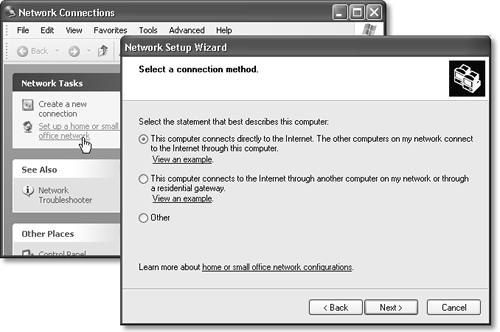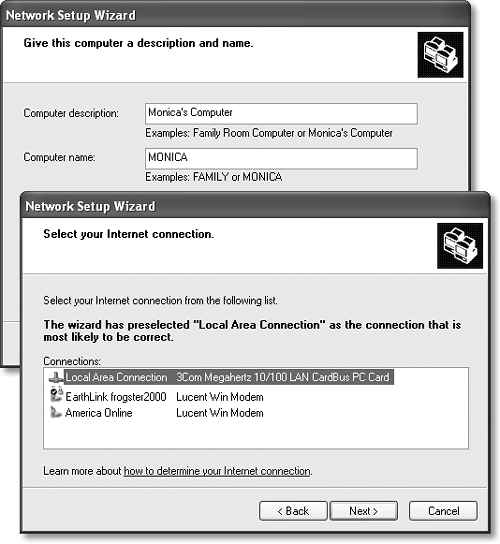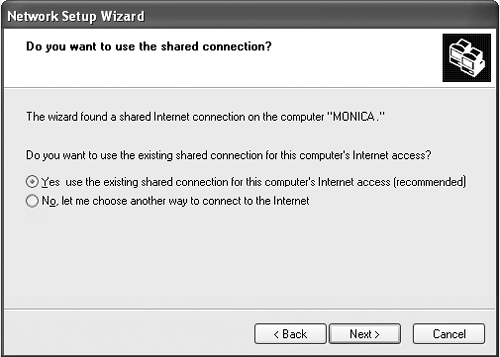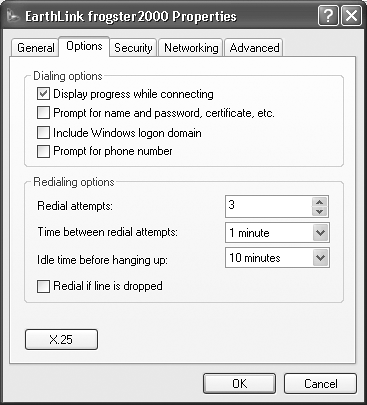| Once you've set up the networking equipment, you have to inform Windows XP Pro about what you've been up to. You also have to configure your computers to share their files, folders, printers, modems, Internet connections, and so on. Fortunately, the Network Setup Wizard handles this duty for you. (You must have an Administrator account to run this wizard.) To launch the wizard, choose Start  Control Panel, and then open Network Connections. In the task pane at the left side of the window (Figure 18-2), click the link that says, "Set up a home or small office network." Control Panel, and then open Network Connections. In the task pane at the left side of the window (Figure 18-2), click the link that says, "Set up a home or small office network." Figure 18-2. Left: Start the Network Setup Wizard by clicking this link. Right: Select the option that best describes this computer's relationship to the Internet. If the PC will be the gateway to the Internet for other PCs on the network, choose the first option. Otherwise , just choose Other to tell the wizard as much.  A welcome message appears; click Next . The remaining screens of the wizard are as follows . 18.4.1 "Before you continue" The screen contains a link called "checklist for creating a network." If you click it, you see a help page that guides you through the steps of setting up a network. It incorporates much of the information you've read so far in this chapter. It also reminds you that if you plan to use Internet Connection Sharing, described earlier, you should ensure that your gateway Windows XP machine can get online before proceeding with the wizard. When you're finished reading the checklist, close its window and then click Next. 18.4.2 "Select a connection method" The next wizard window starts the process of setting up Internet Connection Sharing (see Figure 18-2, right). Your next step depends on your plans for your network and Internet use: -
Each PC will go online independently . If sharing a single Internet connection isn't the point of your networking efforts, click the Other button (Figure 18-2); on the next screen, click "This computer connects to the Internet directly or through a network hub." In other words, your various networked PCs will each connect directly to the Internet. No connection sharing is involved. -
This is the computer with the connection . If the computer you're at now is the one connected to the Internet ”that is, if it's the gateway computer ”click the first option: "This computer connects directly to the Internet. The other computers on my network connect to the Internet through this computer" (Figure 18-2). NOTE If your DSL service is for multiple fixed IP addresses, then your computers can share the connection without having to choose one single computer as the host. -
This isn't the computer with the connection . If you like the idea of sharing a PC's Internet connection, but the machine you're using now isn't the gateway machine, choose the second option: "This computer connects to the Internet through another computer on my network or through a residential gateway." -
You have a router . If you've bought a router (residential gateway), you won't be needing the built-in Windows Internet Connection Sharing feature. Once again, you should click the second option ("This computer connects to the Internet through another computer on my network or through a residential gateway"). -
You don't plan to use the Internet at all . If you just want to set up connections among your computers ”but none of them ever goes online ”click Other, then click Next, and then turn on "This computer belongs to a network that does not have an Internet connection." 18.4.3 "Select your Internet connection" If you indicated that the computer you're setting up will indeed be connecting to the Internet, the wizard now shows you a list of the ways you've set up for your PC to get online (Figure 18-3). Each represents a different method of getting onto the Internet ”network (Local Area Connection), America Online dial-up, your DSL account, or whatever. Turn on the one you want to use, and then click Next. Figure 18-3. Top: Every computer on a Windows network (even a big network in a business environment) must have a unique name . Computer names and workgroup names are limited to 15 characters , without spaces. Hyphens and apostrophes are OK, but most other punctuation is forbidden. Bottom: Tell the wizard how this machine connects to the Internet. See Chapter 10 to find out how these account names got here.  18.4.4 "Give this computer a description and name" On this wizard screen (Figure 18-3), you see a place to give your PC its unique name. For example, if you have a laptop and a desktop PC, you might give them names like Porteg and Millennia (or Kirk and Spock, for all Windows cares). Of course, you already gave your computer a name when you installed Windows XP; that should be the name you see here. 18.4.5 "Name your network" On the screen, you're supposed to make up a name for your workgroup (mini-network). Every PC on your network should have the same workgroup name (it doesn't have to be MSHome, as much as Microsoft might like it). 18.4.6 "Ready to apply network settings" Click Next. On the next wizard screen, you see a summary of your settings. If it all looks good, click Next, and wait a few minutes while the wizard scurries around, applying various internal settings. 18.4.7 "You're almost done" Your first PC may now be correctly configured to be part of an office network, but it faces the problem of the first telephone owner: Who ya gonna call? Your next step, therefore, should be to run the Network Setup Wizard again on each of your other PCs. As indicated by the wizard screen before you now, getting the wizard onto those other machines depends on what version of Windows they're using: -
If the next PC has Windows XP . Click the bottom option here, "Just finish the wizard." Click Next, and then click Finish. Now move to the next computer; start the Network Setup Wizard on it, exactly the way you did on the first machine. -
If the next PC has some earlier version of Windows . You'll probably want to run the XP version of the networking wizard. (If you're comfortable plugging in IP addresses, subnet mask numbers , and default gateway settings, you can enter them manually ”but the wizard automates all of this.) XP offers you two ways to go about it: First, you can insert your Windows XP Professional CD-ROM into each of the other PCs. When the Windows Setup program opens up, click the link at the left side called "Perform additional tasks ." On the next screen, click "Set up home or small office networking." The wizard appears, and you're ready to go. Second, you can create a networking setup disk for your older computers. That is, the wizard will transfer a copy of itself to a floppy disk that you can carry to the non-XP machines on your network. If you select this option and then click Next, you're instructed to put a blank formatted disk into the floppy drive. Click Next again to create the disk, which takes only a moment or two. Then eject the disk; for best results, label it for easy identification. Now insert the disk into the floppy drive on the older PC. Open the My Computer icon on your desktop, double-click the floppy drive icon, and double-click the Setup.exe icon. The by-now-familiar Network Setup Wizard appears. No matter how you get the wizard onto the other machines, the experience of using it is precisely as described on the preceding pages ”with two exceptions: -
If you've decided to set up the first computer as the gateway for Internet Connection Sharing, you don't see the complex array of choices illustrated in Figure 18-2. Instead, you see only the simplified options of Figure 18-4. Figure 18-4. If you're using Internet Connection Sharing, the second, third, and subsequent PCs you set up automatically detect the presence of the first one (the gateway computer). Instead of the dialog box shown in Figure 18-2, you get this far simpler version ”and in general, you'll want to select the first option.  -
There's no need to create a network setup floppy disk on the final wizard screen. When it's all over, Windows lets you know that you should restart the computer. At that point, each PC you've visited is ready for network action. 18.4.8 Testing the Network After all of this setup, here's how you can find out whether or not the gods are smiling on your new network. Seated at your Windows XP Pro machine, choose Start  My Network Places. My Network Places. The network window opens, revealing the folders and disks that your machine can "see" (detect) on other computers of the network. The first time you try this experiment, there may not be much to see here. NOTE All recent generations of Windows can "see" each other and work joyously side-by-side on the same network. On the older machines, you would open the equivalent window by double-clicking the My Network Places or Network Neighborhood icon on the desktop instead of using the Start menu. However, if you click "View workgroup computers" in the task pane at the left side of the window, you should see the names and icons of the other computers you've set up, as shown in Figure 18-5. In Chapter 20, you'll find out how to burrow into these icons, using the files and folders of other networked PCs exactly as though they were on your own computer. Figure 18-5. We have network! Your My Network Places window should reveal the presence of other PCs in your network, complete with the names you gave them when plowing through the Network Setup Wizard. This illustration shows Tiles view for clarity, but Windows starts out in Details view.)  If you don't see the icons for your other computers, something has gone wrong. Check to see that: TROUBLESHOOTING MOMENT
Troubleshooting Internet Connection Sharing The Internet Connection Sharing (ICS) feature of Windows XP is worth its weight in gold ”or, to be more precise, it's worth $80. That's about how much you would spend on a piece of equipment called a router, which you would otherwise need to share one Internet connection among all the PCs on your network. If you have a high-speed connection like a cable modem or DSL, keeping your shared Internet system working is fairly simple. Just remember that the gateway PC must be turned on ”and turned on before the other computers on the network ”in order for the other PCs to get online. Remember, also, that the Personal Firewall feature should be on for all PCs except the gateway computer. (See Section 10.4.1.)

If you use a dial-up modem, however, you may wind up having to do a little more fine-tuning. For example, if you open your Web browser on a client computer (that is, not the one with the Internet connection), the host computer dials. Unfortunately, dialing and connecting take time; before the host computer has finished making the connection, your Web browser may already have reported that the Web page can't be opened. Similarly, your email program may report that "the server isn't available," simply because it took an especially long time for the host computer to make the connection. In either case, simply wait a moment and then try again: in your Web browser, click the Refresh button; in the email program, click the Send/Receive button again. This time, your PC should find the connection and succeed in getting online. Another typical problem: The host computer insists on connecting to your Internet service provider 24 hours a day, tying up the household phone line all day long, redialing every time it loses the connection. Fortunately, it's easy enough to give Internet connection sharing some behavior-modification therapy . On the gateway PC, open the Network Connections icon in your Control Panel. Right-click the connection icon for your Internet service provider; from the shortcut menu, choose Properties, and click the Options tab. Make sure "Redial If line is dropped" is turned off, and set "Idle time before hanging up" to a reasonable number ”say, ten minutes. While you're here, you may as well turn off "Prompt for name and password" and "Prompt for phone number" to streamline the connection process, so that Windows XP won't bother you for this information every time you try to connect. Also while you're here, you may as well visit the Advanced tab. On the gateway PC ”the one connected directly to the Internet ”all of these checkboxes should be turned on. On the other machines, these checkboxes should be turned off. |
-
Your cables are properly seated in the network adapter card and hub jacks . -
Your Ethernet hub (if any) is plugged into an electrical outlet. -
Your networking card is working. To do so, open the System program in the Control Panel. Click the Hardware tab; click the Device Manager button. Look for an error icon next to your networking card's name (see Chapter 13 for more on the Device Manager). If you don't find a problem, rerun the Network Setup Wizard. If that doesn't work, you'll have to call Microsoft or your PC company for help. |



 Control Panel, and then open Network Connections. In the task pane at the left side of the window (Figure 18-2), click the link that says, "Set up a home or small office network."
Control Panel, and then open Network Connections. In the task pane at the left side of the window (Figure 18-2), click the link that says, "Set up a home or small office network." 
